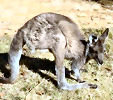 Read this most amazing - albeit short - account of the latest success of wildlife carers Professor Steve Garlick and his wife Dr Rosemary Garlick, and their protocol. Perhaps wildlife carers may be inspired to learn from these carers, instead of putting such a badly injured kangaroo in the 'too hard' basket and euthanasing?
Read this most amazing - albeit short - account of the latest success of wildlife carers Professor Steve Garlick and his wife Dr Rosemary Garlick, and their protocol. Perhaps wildlife carers may be inspired to learn from these carers, instead of putting such a badly injured kangaroo in the 'too hard' basket and euthanasing?

Many complex injuries
Trooper has now almost fully recovered from 9 fractures, including 2 compound fractures, and a patella tendon repair. We have now another with 12 fracture cases, including 9 with fractured ribs, fractured sternum, fractured scapula and subluxed cervical vertebrae. These animals have such determination to recover. (Photo of Trooper now fully healed and close to being ready to release back into the wild.)
We are doing dozens of fracture repairs now. Virtually every case of a severely animal that comes to us (now four per week) has resulted from an motor vehicle accident in which the driver did not stop to lend a hand or make a call for assistance. The animal was left to suffer or be killed by further vehicles or foxes. Their chance of being helped in most cases rests in the hands of other more caring drivers in the immediate vicinity.
Thanks to the help of amazing wildlife vet Dr Howard Ralph - http://www.southerncrosswildlifecare.org.au - Trooper will be free again soon.
Our protocol for treating wildlife with significant injuries
First step: In any macropod rescue where there is significant injury you need to give sedation and importantly pain relief. Animal Valium (Pamlin) is not enough for pain relief. We give injectable Tramil. If the injury is minor you could get away with children's Painstop, but its not enough for a fracture. This treatment is important if there is no veterinarian immediately available. If the injury is a fracture, then splint support to stabilise the fracture may be required as the best form of pain relief. We give injectable Vitamin E and Selenium to reduce the risk of myopathy.
Second step: Have an assessment of the injury and decide whether it can be treated. Things to consider here are the type of injury (where the fracture is and what kind of fracture it is – an x-ray may be needed at some point), size of the animal and whether you have the facilities and knowledge available for the long term rehabilitation phase. Larger animals may be more difficult to manage in the rehabilitation phase but of course it can be done and we do it all the time.
Third step: Either take the animal to a veterinarian for treatment or undertake at least some of the treatment yourself. A course of antibiotics will generally be needed. We use Betamox LA and Baytril together to cover as wide a spectrum of infection as possible, initially.
Fourth step: If you are carrying out some of the treatment yourself if you know what you are doing with a limb fracture. Under strong sedation (Pamlin may not be enough here and you may need Xylazine) and pain relief you may need to put traction on the limb to bring the bones into alignment if they are displaced or compound, clean the wound site with saline and Betadine or similar, splint and bandage with the leg in alignment with the toe and sitting in either the right angle position or slightly dorsiflexed.
The rest will be up to the veterinarian once the x-ray has been seen.
I haven’t given any medication dosages in the above but could do so if needed.
Hope this is helpful. We do many of these for animals we rescue ourselves or that others bring to us. However generally if the animal is large and the fracture is substantial and complex, we probably would not try to rehabilitate. Large animals are difficult to manage in rehabilitation if the fracture is significant.
As I travel through the Australian bush I find myself apologising for being human to all the wildlife I come upon. And if you could hear a distressed animal’s quiet sobbing…what would you do?
Judge your life not by how good you are, but rather by what good you do.
Professor Steve Garlick PhD, FAUCEA
University of Newcastle NSW, University of Technology Sydney NSW
2009 Shining World Compassion Award
President, Animal Justice Party of Australia

Comments
Gloria o'possum (not verified)
Sat, 2013-06-01 10:44
Permalink
Court denies man right to keep roo he rescued and raised
Easy to kill kangaroos but excessively tight laws about keeping them as pets. People don't usually eat pets, so it's a conflict of interest for the kangaroo meat trade.
Humans make me puke. Read the below. Justice is a joke in this country.
Gloria
Anonymous (not verified)
Sat, 2013-06-01 12:19
Permalink
Cold hard inflexible laws
Anonymous (not verified)
Mon, 2013-07-29 05:27
Permalink
Pets that have been saved, not wildlife pets!
Add comment